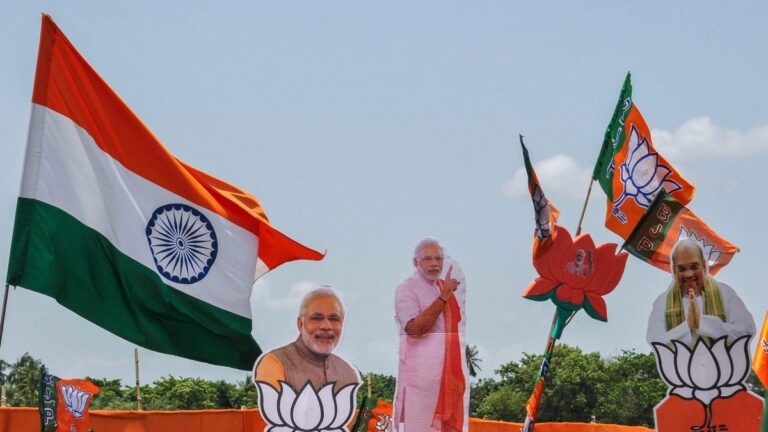Last updated:
It remains to be seen whether the BJP will be able to expand its support among tribes and break the JMM-led alliance in the state elections, as JMM’s appeal among tribes remains a key factor.

To counter the JMM, the BJP is focusing on fusing tribal identity cards with Hindutva politics. (PTI)
In the eastern state of Jharkhand, where tribal influence is strong, voting is scheduled to be held in two phases on November 13 and 20. The state is ruled by the Jharkhand Mukti Morcha (JMM), a tribal-based party aligned with the Congress. and Rashtriya Janata Dal (RJD). The main opposition party, the Bharatiya Janata Party (BJP), is contesting 68 seats and hopes to regain power in the state. The remaining 13 seats will be held by the National Democratic Alliance (NDA) constituents All Jharkhand Students Union (AJSU), Janata Dal (United), JD (U) and Lok Janshakti Party (Ram Vilas) or LJP (R ) was left behind.
But the saffron party knows that the fight for Jharkhand will not be easy as the main opponent here is not the Congress but the JMM, which is using tribal identity cards to garner support. . The JMM, led by Chief Minister Hemant Soren, entered the battlefield holding back its allies Congress and RJD. The JMM is contesting 41 seats while its allies are contesting the remaining 40 seats.
JMM poses a strong challenge to the BJP
For the BJP, fighting the JMM’s tribal card is a difficult task due to the BJP’s own past mistakes. When the saffron party-led NDA won a clear majority for the first time in the 2014 state elections, the party’s central leadership opted to make Raghubar Das, a non-tribal, the chief minister. Since the state was established in 2000, it had never had a non-tribal chief minister until 2014.
However, Das’ tenure was unpopular, especially among tribals, who make up about 27 percent of the state’s population. As a result, the Bharatiya Janata Party lost the polls in the 2019 elections, winning only two of the 28 seats reserved for Scheduled Tribes. Sitting CM Das himself lost from the Jamshedpur East seat to independent Saryu Rai, who is contesting from the same seat as a JD(U) candidate, this time under the NDA banner.
Statistics from the last assembly results show that the BJP needs to improve its performance against the JMM if it is to return to power this time. Of the 25 seats won by the saffron party last time, JMM came runner-up with only three seats. Meanwhile, the BJP defeated the JMM alliance and won 13 seats (nine against the Congress and four against the RJD). Of the remaining nine seats won by the BJP, AJSU came second with four seats, while BSP and Marxist Coordination Committee (MCC) came second with two seats each. Babulal Marandi’s Jharkhand Vikas Morcha (Prajatantrik), or JVM(P), came runner-up to the BJP with just one seat.
This shows how poorly the BJP performed against the JMM in the last elections.
BJP’s corrective measures after 2019 losses
Knowing that the experiment with appointing a non-tribal chief minister had failed, the saffron party leadership reinstated the state’s first chief minister, Babulal Marandi, into the party in 2020. His party, JVM(P), also merged with the saffron party. B.P.B.I. Marandi is a veteran tribal leader who quickly became leader of the opposition in the state legislature. Last year, he became state party president. In the same year, the party’s central leadership moved Raghubar Das out of the state by appointing him governor of neighboring Odisha, a decision taken by the President of India and effectively carried out by the Bharatiya Janata Party government led by Narendra Modi. I was disappointed. After Drupadi Murmu was sworn in as India’s first tribal president with NDA support, the Bharatiya Janata Party has been emphasizing this and trying to rally support among the state’s tribals.
Despite all these efforts, the BJP suffered a shock in this year’s assembly elections, losing all the five parliamentary seats held by the ST. This effort did not bear fruit, most likely because the BJP’s tribal identity card faced strong opposition from the JMM. Because the JMM played the emotional tribal card by highlighting the arrest of Hemant Soren by the Enforcement Directorate (ED), an agency under the Centre’s purview. The JMM emotionally reached out to the tribals and succeeded in portraying the BJP, which had arrested the tribal chief minister through the ED, as an ‘anti-tribal party’.
Although the Lok Sabha results showed the influence and dominance of the JMM among the tribals with Hemant Soren being released from jail and once again heading the JMM-Congress-RJD government, the emotional cards are expected to be less effective. It has already been used in Lok Sabha elections.
BJP’s mix of Hindutva and tribal identity cards to woo tribals
The BJP also includes JMM leader Champai Soren, who served as the state chief minister this year while Hemant Soren was in jail. Champai was dissatisfied with the fact that he was forced to resign as chief minister when Hemant Soren was released. Despite having this JMM leader in the party, the saffron party faces challenges from the JMM, which is dependent on various welfare schemes launched by the government, despite facing an anti-incumbent movement. I’m aware.
To counter the JMM, the BJP is focusing on fusing tribal identity cards with Hindutva politics. This became especially clear on October 2 when Prime Minister Narendra Modi launched an attack on the JMM government, accusing it of harboring infiltrators at the expense of national identity and culture. He particularly mentioned how the rise of invaders had changed the demographics of the Santal Parganas, resulting in a decline in the tribal population.
There is no doubting the Bharatiya Janata Party’s clear strategy to use the Hindutva card to wean tribals away from the JMM, with Mr. Modi himself paving the way, portraying the JMM as being against tribal interests.
In the last state election, out of a total of 18 seats, the JMM secured 9 seats and the Congress secured 4 seats, while the Bharatiya Janata Party won only 4 seats in the Santal constituency, hence the reference to Santal Parganas. is extremely important.
Prime Minister Modi did not focus solely on the Hindutva agenda in his public meetings. He also attacked the JMM government for failing to provide employment and launched schemes aimed at tribal development and established various Eklavya schools for tribal students. This shows how the BJP is carefully combining tribal identity and Hindutva policies to engage Hindu tribes, while at the same time leveraging the influence of development plans by the Center and the JMM’s tribal card. It also highlights the unabated failures of the state government.
The saffron party is trying to repeat the same Hindutva card that was successful among tribals last year in the Chhattisgarh state elections. Although the party focused on converting tribals to Christianity, the issue was also raised by the Rashtriya Swayamsevak Sangh (RSS), the ideological parent of the Bharatiya Janata Party, and its affiliates in Jharkhand. This strategy proved effective and the party increased its representation of ST seats from 3 to 17 out of 29 seats in the elections. The party recognized tribal support and appointed tribal leader Vishnu Deo Sai as chief minister of Chhattisgarh. This also served as a message to tribals, including those in neighboring Jharkhand, that the saffron party attaches importance to the saffron tribe.
With JMM’s appeal among tribals remaining a key factor, the BJP will rely on a combination of tribal identity and Hindutva to increase support among tribals and defeat the JMM-led alliance in state elections. It remains to be seen whether this will be possible. It exploited Hindu tribals and anti-incumbent sentiments against the JMM government.
Sagarneel Sinha is a political commentator and tweets @SagarneelSinha. The views expressed in the article above are personal and solely those of the author. They do not necessarily reflect the views of News18.

